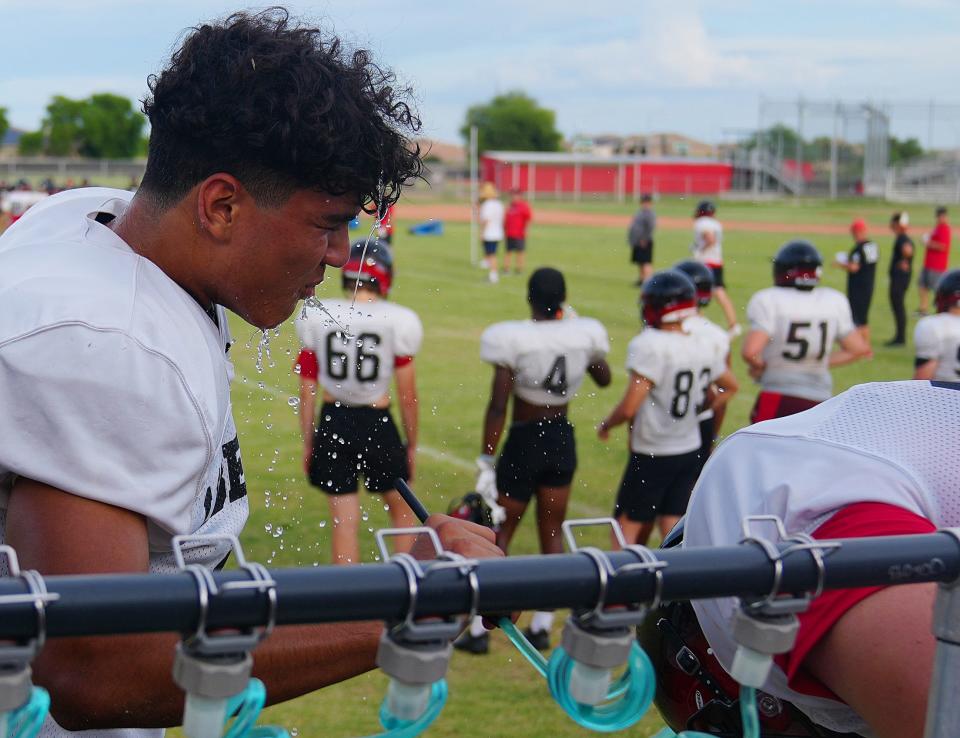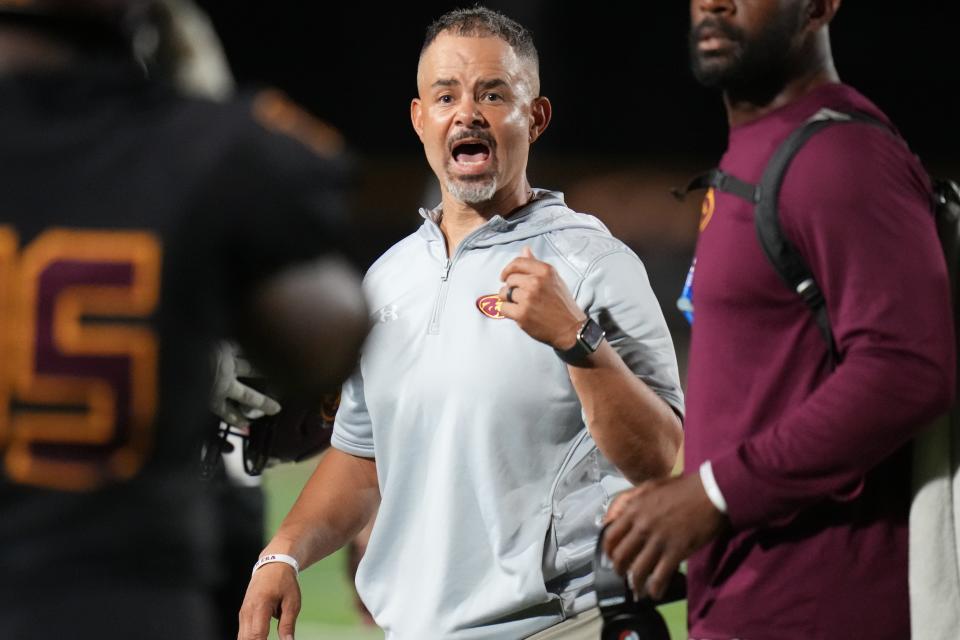How are high school football teams dealing with Phoenix-area record heat wave?

The heat records keep stacking up as high school football teams in the Phoenix area prepare for the upcoming season.
Games don't start until Aug. 17, but as the unrelenting sun bears down on the Valley teams continue to grind as they get ready for the 2023 season. While some headed north or to the cool beaches in California, others stayed home to conduct summer camps.
Chandler and Phoenix Mountain Pointe were two that stayed home last week and worked during this current long streak of 110-plus-degree days of heat.
To try to beat the heat, Chandler began at 7 a.m. Mountain Pointe gathered after sundown, at 8 p.m. for two hours, as well as early in the morning.
"It wasn't bad," Chandler coach Rick Garretson said. "It was a little humid. We did that Monday, Tuesday. We went early in the morning Thursday with a practice at 7:15. Same thing. We take all the precautions. We get them under the tree line, under the tents, make sure they get plenty of water.
"Unfortunately, it's the world we live in. I know when I moved to Arizona from Orange County (in Southern California), my kids were outdoor athletes. I'm wondering, 'How do the kids deal with it?' "
There are very few breaks year-round in high school sports anymore, and with teams on the field, in the weight room, getting in conditioning work.
The official Arizona Interscholastic Association practices in helmets begin on Monday for 3A through 1A teams; July 31 for 4A through 6A teams. But early workout can take place, and they have, during what's been a brutal July even for a region where 100-degree summer weather is the norm.
It hit 110 degrees in Phoenix on Thursday before it hit noon. It was 115 before 2 p.m., and the official high at Sky Harbor was 119, breaking yet another record for the highest temperature on the date ever.
With temperatures threatening to reach 120 degrees, what are teams doing? What advice is medical personnel giving? What can the AIA do to make sure there are no stories about kids being rushed into emergency rooms due to heat strokes?
"The big thing is, critical in heat, the first three to four days of practice are absolutely really important," AIA Executive Director David Hines said. "There are some requirements that they have to follow. Helmets only to start with.
"We recommend going in the evening versus early in the morning. One of the two, where you're staying away from the direct sun. And to make sure they get water."
AIA heat policy
The AIA has a heat acclimatization and external heat illness management policy in its bylaws that schools must follow.
There is a list of things designed to educate the coach and athlete, such as recognizing and managing exertional heat illness; risks associated with exercising in hot, humid environmental conditions; the need for gradual acclimatization over a 14-day period; guidelines for proper hydration; implementing practice/competition modifications according to local temperature and relative humidity readings; management/treatment guidelines for heat illnesses and heat stroke; and appropriate guidelines for return to play after heat illness.
According to the AIA bylaws, the first five days of practices in helmets during the heat-acclimatization period, athletes may not practice more than once a day; and, if the practice is interrupted by inclement weather (mainly seasonal monsoon storms), it recommends practice only if conditions are deemed safe; and total practice times should not exceed three hours in one day. A one-hour maximum walk-through is permitted for the first five days, however, a three-hour recovery period should occur between those two. The helmet is the only protective padding for the first three days, then shoulder pads are allowed on the fourth day. On the fourth day is when blocking sleds and tacklings dummies can be used.
Hines said that athletic trainers should have ice baths ready, cold compresses to keep bodies cool if a player suffers heat illness.
Dr. Erik Mattison, director of the emergency department of Dignity Health Chandler Regional Medical Center, said the best time to of day for outside workouts is as early in the morning as possible. Even then, it has been in the 90s in the Phoenix area.
"That’s when the temperature is lowest — but during this heat wave, the overnight lows have been in the 90s," Mattison said. "Evening workouts are OK when temperatures are moderate, but for now, it’s still dangerously hot."
Mattison said that temperatures have been well above 100 degrees late at night.
"And I would strongly advise against late-afternoon workouts as that is the hottest part of the day," he added. "Also, I would urge schools to consider indoor workout options during the most excessive heat."

Mountain Pointe coach Eric Lauer said that with the expenses involved to find a summer camp in a cooler climate, the time it takes for logistics, and having decent facilities at home, it was easier to stay in the Valley for camp.
"We get more practice time in," he said. "The other thing is, I want them to get used to being uncomfortable. That heat has been nasty. We worked out from 8 to 10 at night and we went early in the morning.
"We go no-huddle, so we're trying to run as many plays as we can. In the desert, that's probably a no-go. But we count plays Mondays and Tuesdays. We make sure it's more of a recovery day Wednesdays. We get after it on Thursday. It's not a walk-through, it's a run-through. So we're ready to get after it Friday nights. Wherever we go, we get there early and fully get dressed there, because we take about 20 minutes to get a full stretch."
Lauer said at night, there was more team stuff, being more mindful of what they could get done and not putting too much exertion on players.
"We're only going to get so much, because it is so hot," Lauer said. "Practice planning has to be a little different. We can change things on the fly, because we stayed at home, knowing we may need a little extra break at this time (of the day)."
Poston Butte coach Dain Thompson said that several years ago the program made a switch in practice times to avoid the hottest part of the day. The freshman team practices in the morning and the junior varsity and varsity teams go from 6 p.m. to 8, he said.
"This takes a lot of the sun off the players, and coaches for that matter," Thompson said. "It is still hot but avoiding the direct sun has made a significant difference."
'Building trust': Arizona high school football teams escape heat at camps
It starts with hydration
Mattison said it all starts with hydration for athletes, and the process has to begin the day before practice.
"It’s not enough to gulp a bottle of water on the way out the door," Mattison said. "Cut back on sodas and caffeinated drinks, because those will dehydrate you.
"The rule of thumb is eight ounces of water every 15 minutes or a liter every hour. But that's just to keep up with normal losses, not if you're doing something extra exertional. If you're feeling thirsty and you're having that crazing feeling of thirst, you're already in danger of heat exhaustion. It's also important to note that if athletes are taking creatine or other supplements for muscle growth, that can potentially put them at higher risk for heat-related injuries due to fluid shifts in their body."
The Arizona Rattlers are an indoor football team, but doesn't have an indoor practice facility. It practices at Gene Autry Park in Mesa, outside, usually from 10 a..m., to 11:30 each morning.
On Thursday, coach Kevin Guy, seeing that it could reach 119 degrees, changed it up and had a 7:30 a.m., workout followed by a team meeting, instead of the other way around, as his team prepares to play Northern Arizona on Saturday in the first round of the Indoor Football League playoffs at Footprint Center.
"We were off the field before it hit 100," Guy said. "I think that's smart. In 2010, we did practice at night. A lot of it is the sun just beating down on you. Sometimes, you can deal with the heat. It's the sun beating down. We practiced at night that year and I don't remember it being that bad at all. But this year, this week, this is the first time we went early in the morning."
So what should athletic trainers and coaches be on the lookout for?
Muscle cramps, nausea, extreme thirst, Mattison said.
"Those are telltale signs of heat exhaustion," he said. "If an athlete is feeling lightheaded, they are probably experiencing heat exhaustion. That’s the time to cool off, get out of the heat, get cool water on you and drink water.
"Another tip is for athletes to monitor their urine. If you’re unable to urinate or it’s a scant amount or it’s dark, that’s a sign your body is trying to hold onto fluids because you are dehydrated."
'Chris will live in our hearts forever': Cesar Chavez High School mourns football camp tragedy
Chandler Hamilton football coach Mike Zdebski pays attention to what school athletic trainer Lance Michael advises.
"We do what he says," Zdebski said. "From reducing time, to removing all equipment, to moving practices to the morning before school are all options he presents to us."
To suggest human-interest story ideas and other news, reach Obert atrichard.obert@arizonarepublic.com or 602-316-8827. Follow him on Twitter@azc_obert
This article originally appeared on Arizona Republic: How are high school football teams dealing with Phoenix heat wave?

